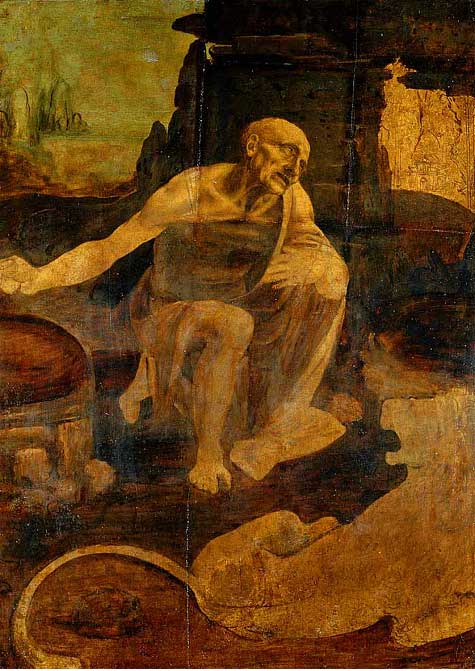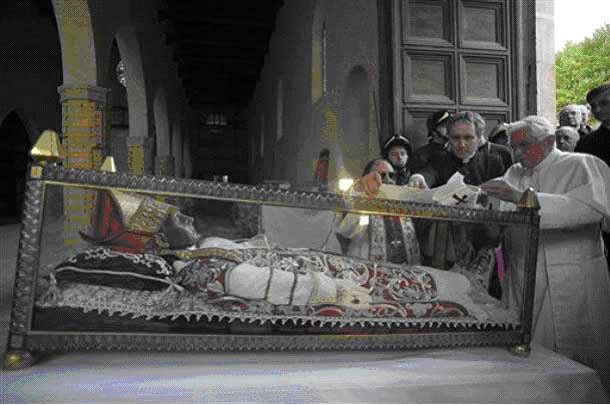Benedict, Monks, Mystics, and Hermits

Saint Jerome in the Wilderness, Leonardo da Vinci,
By Cornelius Sullivan
Pope John Paul II was seen in person by more people than any one else in human history. Pope Benedict XVI was seen and heard by countless numbers of people, of all faiths, in person and through the electronic mediums. The Emeritus Pope will now be hidden. He acknowledged that he can no longer, after having been Pope, have a private visible life, such as the one he once had before becoming Pope; traveling, teaching, and giving lectures.
He will live a life of contemplation and prayer in a convent in the
And if we think that a man can be understood more fully by looking at his friends we can see that his desire to be a contemplative scholar monk has been present for some time. He has written extensively about Saint Benedict, the founder of The Benedictine Order of Monks, and about
On

Pope Benedict at the tomb of Pope Celestine V.
The circumstances of the abdication of Pope Celestine V from the Petrine office reads like fiction. After a conclave that lasted for two years, unable to make a decision, the contentious worldly group of Cardinals chose the holy scholarly man. At the age of 80, he was two years older than Cardinal Ratzinger when he was chosen.
Celestine V wore hair-cloth as a penance and modeled himself after Saint John the Baptist. He fasted every day except Sunday. Many faithful came to him to imitate his rule of life, there were 600 monks called “Celestini” in 36 monasteries. He was a pious leader supported only by the Franciscans who were opposed to the worldly corruption in the Church.
He asked the cardinals to not name him Pope. The scholarly Pope was not able to govern the corrupt Church and he renounced his office after five months. His successor, Pope Boniface VIII, fearing that Celestine would still retain influence because he was known as a holy man, locked him up and subsequently he died at 87 years old.
Saint Benedict lived from 480 to 547 AD. He is the founder of Western Monasticism. Wednesday in his last weekly audience, Pope Benedict said that he will serve the church “in a new way.” “I no longer wield the power of the office for the government of the Church, but in the service of prayer I remain, so to speak, within St. Peter’s bounds. St. Benedict, whose name I bear as Pope, shall be a great example in this for me. He showed us the way to a life which, active or passive, belongs wholly to the work of God. His order has two parts: to pray, and to work. Orare, e laborare. First, pray, then, work. Ora, et labora.”
The Pope Benedict before Ratzinger, Pope Benedict XV, wrote an encyclical on
When Pope John Paul pressed Cardinal Ratzinger to become Prefect for the Doctrine of the Faith, the office that he held for twenty five years, the Cardinal asked, “Can I still write my books?” When Ratzinger was chosen Pope, he would not move from his apartment down the street into the
I had the privilege to listen Wednesday to three theologians who had personal contact with Pope Benedict VXI , before when he was a Cardinal. They said what we have known all along, that he is a shy man, and that he exuded great peace.
You may hear piano music coming from the
We will see, at some point, a Funeral Mass for the Pope Emeritus celebrated by a Pope. In Modern history it is unprecedented for a Pope to say a Mass for a Pope.